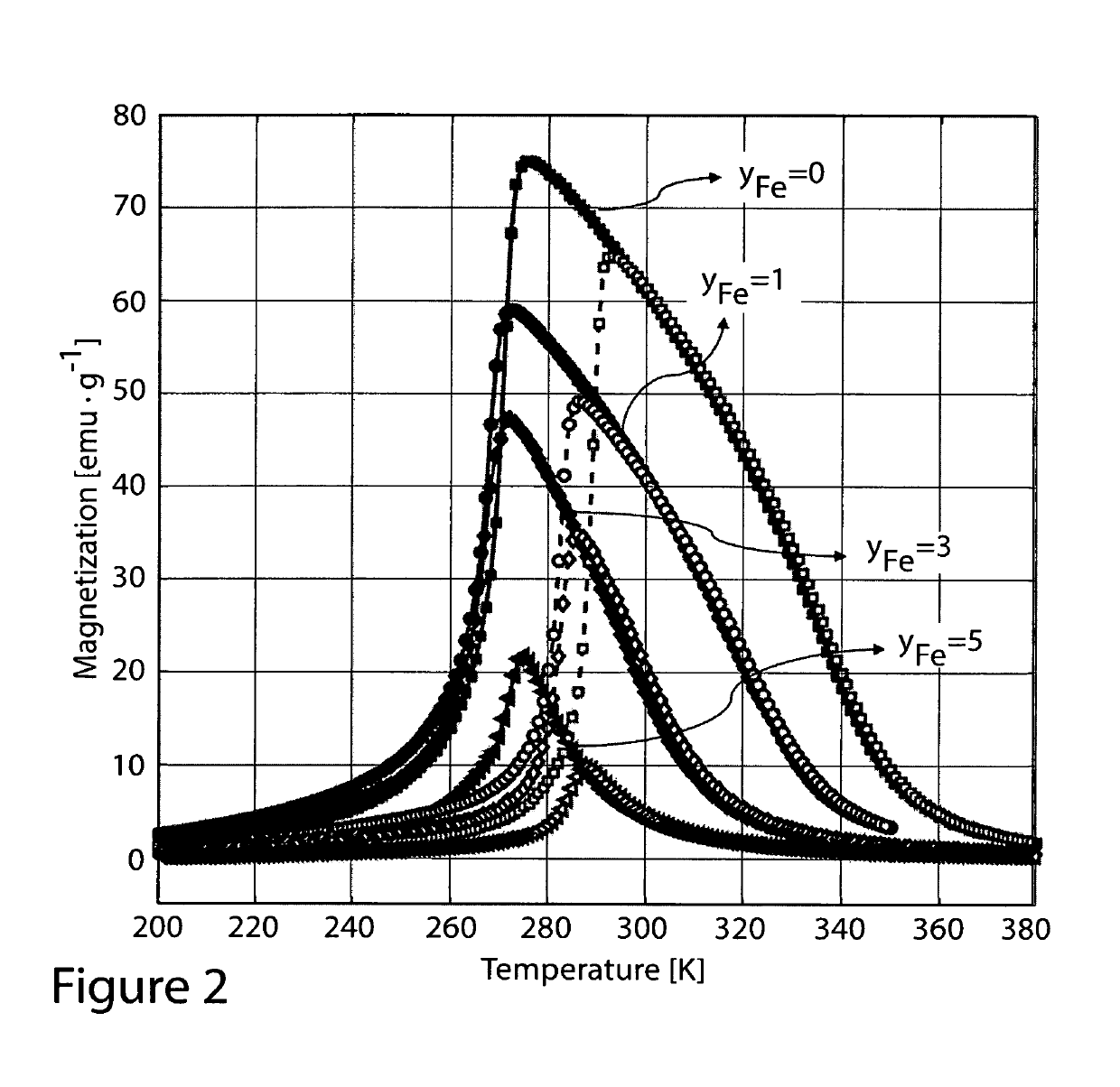Highly tunable, inexpensive and easily fabricated magnetocaloric materials
- Summary
- Abstract
- Description
- Claims
- Application Information
AI Technical Summary
Benefits of technology
Problems solved by technology
Method used
Image
Examples
example 1
idification
[0038]Different compositions Ni50-x CoxMn35Ti15 with x indicated in Table 1 below were rapidly solidified as melt-spun ribbons prepared using a melt-spinning technique with the following range of operating parameters: induction melting of the ingot in a quartz crucible under 250 torr pressure of high purity helium gas and then ejected at 1473 K at 105 torr overpressure of the helium gas onto a copper chill wheel rotating at a tangential speed of about 20 m / s. Melt-spinning resulted in chemically homogenous materials with well-refined sub-micron size grains. The melt spun materials have a chemically homogenous microstructure or nanostructure.
TABLE 1Ni50−xCoxMn35Ti15 Melt Spun Ribbons:TransitionTemperatureHeat treatmentCo concentrationon heating, TMtemperatureΔS for ΔH = 2T(x)(K)(K)(J · kg−1 · K−1)10334No treatment11322No treatment12.5288No treatment27.212.528987312.528997312.5293107312.5296117313.7263No treatment17.715189No treatment4.38
[0039]X-ray diffraction and magnetiz...
example 2
idification of Chemically Substituted Compositions
[0040]Different compositions of substituted Ni—Co—Mn—Ti alloys were prepared as follows:
Ni37.5-yT′yCo12.5Mn35Ti15, where T′=Cu or Fe with 0
Ni37.5Co12.5-yFeyMn35Ti15, with 0
[0041]The fabrication was conducted with high purity elements being weighed stoichiometrically (with 3.5 wt. % of Mn in excess to account for Mn evaporation) and then arc-melted, followed by drop-casting and melt-spinning. The latter was performed induction melting of the ingot in a quartz crucible under 250 tor pressure of high purity helium gas and then ejected at 105 torr overpressure at 1473 K onto a copper chill wheel rotating at a tangential speed of about 20 m / s.
[0042]The compositional accuracy and single phase were verified with scanning electron microscopy and energy dispersive analysis (SEM and EDX, respectively). The single phase was also verified via x-ray diffraction (XRD) analysis at room temperature.
[0043]Heat treatment experiments were...
examples 1 and 2
Results of Examples 1 and 2
[0045]FIGS. 1 through 4 show isofield magnetization measurements of the as-melt-spun ribbons prepared without heat treatment. As one may see, each elemental substitution presents a different effect; Ni37.5Co12.5Mn35Ti15 shows a sharp magneto-structural transition around room temperature which is promising for magnetic refrigeration. Increase of Co content above x=12.5 leads to increase of thermal hysteresis and to the decrease of transition temperature TM. Furthermore, the increase of Co content also leads to the decrease of the sharpness of the transition. When the Co content is reduced below x=12.5, the transition temperature TM increases, the hysteresis is slightly reduced.
[0046]Chemically substituted alloy compositions, Ni50-xFexMn35Ti15 with x=5, 10, 13.5 (devoid of Co), were also synthesized but not shown in FIGS. 1 through 4 since these compositions did not show any magnetic transitions of interest, a consequence which can be extrapolated from FIG. ...
PUM
| Property | Measurement | Unit |
|---|---|---|
| Cooling rate | aaaaa | aaaaa |
| Temperature | aaaaa | aaaaa |
| Composition | aaaaa | aaaaa |
Abstract
Description
Claims
Application Information
 Login to View More
Login to View More - R&D
- Intellectual Property
- Life Sciences
- Materials
- Tech Scout
- Unparalleled Data Quality
- Higher Quality Content
- 60% Fewer Hallucinations
Browse by: Latest US Patents, China's latest patents, Technical Efficacy Thesaurus, Application Domain, Technology Topic, Popular Technical Reports.
© 2025 PatSnap. All rights reserved.Legal|Privacy policy|Modern Slavery Act Transparency Statement|Sitemap|About US| Contact US: help@patsnap.com



